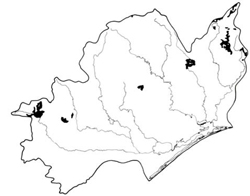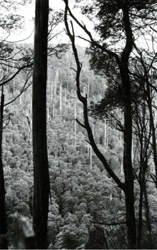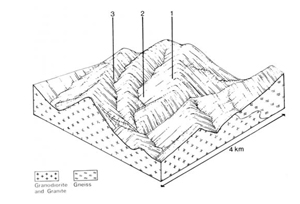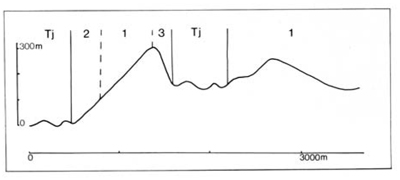Baldhead (Bd)
 | Area: 229 sq. km (1.1%) Baldhead land system is restricted to the granites, granodiorites, gneissic-metamorphic and related coarsely-crystalline, plutonic rocks that occur mostly in the northern parts of the Eastern Victorian Uplands at relatively high elevation. Steep mountains with a ridge and-ravine pattern of dissection dominate, although some peaks are somewhat rounded. Small levees and alluvial flats, not extensive enough to map separately, occur occasionally along a few major streams, notably the La Trobe River. The area is similar in geology and topography to Blomford land system but is much more humid, with a corresponding difference in the vegetation and soils. A cool climate, and high rainfall with parent rocks that weather relatively easily, have produced moderately deep, soils, even on steep slopes. Soils are well-aggregated, particularly in the upper profile, but in some places subsoils are apedal and earthy. They are moderately acidic and permeable. Most of the area carries open forest III with a dense understorey which is layered on more protected aspects; lower, drier slopes carry open forest II. |  A steep slope with Eucalyptus delegatensis (alpine ash) forest. |
| CLIMATE Rainfall, mean (mm)Temperature, mean (°C) Seasonal growth limitations | Annual 900 - 1600; lowest January or February (50 - 90), highest August or September (120 - 180) Annual 8 - 12; lowest July (3 - 7), highest February (16 - 20) Temperature <10°C (av.): April - October Rainfall < potential evapotranspiration: February; frequent winter snow |
| GEOLOGY Age, lithology | Palaeozoic granites, granodiorites, gneissic metamorphics and related coarsely crystalline plutonic rocks |
| PHYSIOGRAPHY Landscape Elevation range (m) Relative relief (m) Drainage pattern Drainage density (km/km2) | Steep mountains with ridge-and-ravine topography 240 - 1360 100 - 680 Dendritic 0.8 |
| PRESENT LAND USE | Mostly uncleared: hardwood forestry (general construction and ash timber); some bush grazing of cattle; apiculture; small areas part of Baw Baw National Park. |
 |  |
| LAND COMPONENT Percentage of land system Diagnostic features | 1 75 Slopes with humid forest (non ash species) | 2 15 Slopes with drier forest, usually at lower elevation | 3 10 Protected slopes with humid ash forest |
| PHYSIOGRAPHY Slope %, typical and (range) Slope shape | 30 - 40, (10 - 60) Straight | 25 - 35. (10 - 60) Straight | 30 - 40, (10 - 60) Straight |
| SOIL Parent Material | Granite. granodiorite and gneissic metamorphic rock | ||
| Description | Often stony, very dark greyish brown sandy loam to sandy clay loam merging into reddish brown sandy clay loam to sandy clay. Soils in component 2 usually shallower and stonier Gn2.11, Gn2.21, Um5.42, Um5.51 | Black to very dark greyish brown sandy loam to sandy clay loam merging into brown or reddish brown sandy loam to clay loam: often stony. Generally deeper than in components 1 and 2 | |
| Classification | Brown and Red Earths, Lithosols | Brown and Red Earths Um6.12, Um6.21, Um6.23, Gn2.11 | |
| Surface texture | Sandy loam to sandy clay loam | ||
| Surface consistence | Soft | ||
| Depth (m) | <2.0 | ||
| Nutrient status | Low to moderate | ||
| Available soil water capacity | Moderate | ||
| Perviousness to water | Rapid | ||
| Drainage | Good | ||
| Exposed stone (%) | Very variable: 0 - 75 | ||
| Sampled profile number | - | - | - |
| NATIVE VEGETATION Structure of vegetation and characteristic species of dominant stratum (+ Predominant species) | Shrubby open forest 11, III: Pure or mixed stands of E. dives (often predominant), E. cypellocarpa. E. obliqua, E. rubida. Minor occurrences of E. pauciflora at higher elevations in N.E. E. viminalis in valleys | Open forest II: E. sieberi generally predominant on mid- to upper slopes and crests: E. macrorhyncha, E. rubida. E. obliqua and E. cypellocarpa associated. Minor occurrences of F. pauciflora at higher elevations in N.E. | Open forest II. often layered: Higher elevations — E. delegatensis Lower elevations — E. regnans+ with or without E. obliqua or E. rubida |
Disturbance | Affected process and trend | Primary resultant deterioration | Causal activities | Primary off-site process | ||
Form | Susceptibility of components | Incidence within components | ||||
| Alteration of vegetation: — reduction in leaf area, rooting depth and/or perenniality — reduction in density of tree roots | Reduced transpiration, resulting in: a) increased deep percolation and leaching b) increased infiltration and regolith wetness Decreased root-binding |
|
|
|
|
|
| Increased exposure of surface soil | Increased overland flow and soil detachment | Sheet and rill erosion | 1,2,3; moderate | Uncommon | Clearing, logging, burning, overgrazing, road and dam building and other earth-moving activities, rabbit burrowing, trafficking by stock and vehicles. | Increased flash flows and sediment load. |
| Increased physical pressure on soil | Increased compaction with reduced infiltration | Structure decline Sheet and rill erosion | 1,3; moderate - high 2; low 1.2,3: moderate | Uncommon Uncommon | Increased trafficking and cultivation, overgrazing, export of organic matter As for sheet and rill erosion above | - Increased flash flows |
| Increased soil disruption | Increased soil break-up | Gully erosion | 1,2.3: moderate | Uncommon | As for sheet and rill erosion above | Increased sediment load. |
| Comments: Good growing conditions generally result in quick regeneration of vegetative cover except on exposed sites at high elevation. | ||||||


